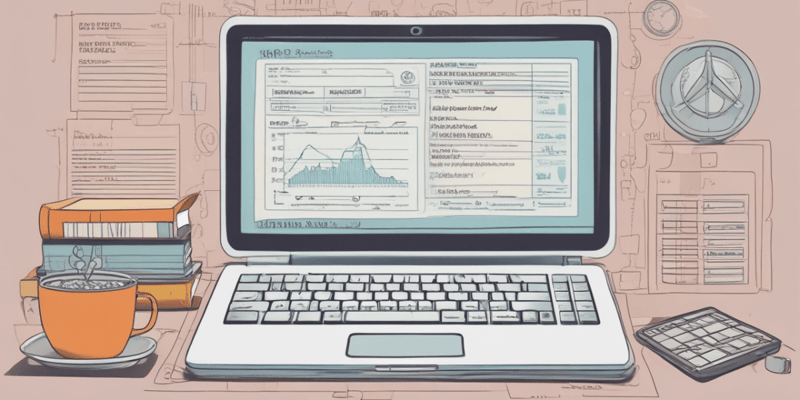Podcast Beta
Questions and Answers
How is a financial asset defined?
Fair value is the price that would be received to sell an asset but not to transfer a liability.
False
What is the definition of a financial liability?
A contractual obligation to deliver cash
If finance raised creates an obligation to make future payments, then it is classified as a ____________.
Signup and view all the answers
Uploaded PDFs retain their original layout, formatting, and design, regardless of the device or platform used to view them.
Signup and view all the answers
Which of the following are common uses of uploaded PDFs? (Select all that apply)
Signup and view all the answers
What advantage do uploaded PDFs provide in terms of document integrity and formatting?
Signup and view all the answers
Uploaded PDFs can be encrypted and password-protected for ______________ and access control.
Signup and view all the answers
How should transaction costs be treated for liabilities?
Signup and view all the answers
A company should always revalue its financial instruments in subsequent years.
Signup and view all the answers
What is the main aim of revaluing a financial instrument?
Signup and view all the answers
If a company receives a loan of £80 with an arrangement fee of £5, the loan liability would be reported at £_____ in the financial statements.
Signup and view all the answers
What is the accounting treatment for arrangement fees if a company does not revalue its financial instruments?
Signup and view all the answers
A company should revalue a loan given to someone if it expects to receive interest and get its principal back.
Signup and view all the answers
What is the accounting treatment for arrangement fees if a company revalues its financial instruments?
Signup and view all the answers
Match the following scenarios with their accounting treatment for arrangement fees:
Signup and view all the answers
What is the purpose of recording arrangement fees, such as the £20,000 cost in the example, separately?
Signup and view all the answers
The effective rate of interest is the same as the nominal rate of interest.
Signup and view all the answers
How is the loan liability calculated at the end of the year in the example?
Signup and view all the answers
The liability at the end of year should include any unpaid _________ cost.
Signup and view all the answers
Match the following statements with the correct category:
Signup and view all the answers
What is the fair finance cost expense reported in the income statement for the year ended 30 September 2016 for Dun plc?
Signup and view all the answers
What is the amount of premium paid at the end of year 4?
Signup and view all the answers
The interest rate is 5%.
Signup and view all the answers
What is the term used to describe the spread of costs over the life of the finance?
Signup and view all the answers
The fair cost of £200,000 is also known as the ______________ rate.
Signup and view all the answers
What is the year-end liability at the end of year 3?
Signup and view all the answers
The premium of £800,000 is paid at the end of year 1.
Signup and view all the answers
Match the following journal entries with their descriptions:
Signup and view all the answers
What is the total amount of cash paid in year 4?
Signup and view all the answers
If a company receives a loan of £80 with an arrangement fee of £5, how should the loan liability be reported in the financial statements?
Signup and view all the answers
A company should always revalue its financial instruments in subsequent years.
Signup and view all the answers
What is the main aim of revaluing a financial instrument?
Signup and view all the answers
If a company does not revalue its financial instruments, the arrangement fees are _______________ in the loan liability.
Signup and view all the answers
What is the accounting treatment for arrangement fees if a company revalues its financial instruments?
Signup and view all the answers
Match the following scenarios with their accounting treatment for arrangement fees:
Signup and view all the answers
A company should revalue a loan given to someone if it expects to receive interest and get its principal back.
Signup and view all the answers
What is the purpose of recording arrangement fees separately?
Signup and view all the answers
What is the purpose of recording arrangement fees, such as the £20,000 cost in the example, separately?
Signup and view all the answers
The effective rate of interest is the same as the nominal rate of interest.
Signup and view all the answers
What is the fair finance cost expense reported in the income statement for the year ended 30 September 2016 for Dun plc?
Signup and view all the answers
The loan liability at 30 Sep 2016 for Dun plc is £19.5 + (1.95 - £__________). = £20.95
Signup and view all the answers
Match the following scenarios with their accounting treatment for arrangement fees:
Signup and view all the answers
What is the main objective of the entity's business model in holding a financial asset?
Signup and view all the answers
A fair value option exists to designate any debt instrument as FVTPL if by doing so it significantly reduces a measurement or recognition inconsistency.
Signup and view all the answers
What is amortised cost for financial instruments?
Signup and view all the answers
Held for trading liabilities are reported at ___________, while other financial liabilities are reported at amortised cost.
Signup and view all the answers
How are arrangement fees treated for liabilities if a company does not revalue its financial instruments?
Signup and view all the answers
Match the following scenarios with their accounting treatment for arrangement fees:
Signup and view all the answers
What is the purpose of recording arrangement fees separately?
Signup and view all the answers
The liability at the end of the year should include any unpaid ______________ cost.
Signup and view all the answers
Study Notes
Financial Instruments - IFRS 9 & IFRS 7
Definitions
- A financial instrument is a contract that gives rise to a financial asset of one entity and a financial liability of another entity.
- A financial asset is a contractual right to receive cash.
- A financial liability is a contractual obligation to deliver cash.
- Fair value is the price that would be received to sell an asset or paid to transfer a liability in an orderly transaction between market participants.
- Examples of financial assets: financial investments, cash, trade receivables.
- Examples of financial liabilities and financial equity: equity shares, loans, bonds, convertible debentures, preference shares.
Classifying Finance Raised as Equity / Liability
- Long-term finance raised needs to be reported in the Balance Sheet, classified as liabilities or equity.
- An instrument is reported as a liability if its substance meets the definition of a liability.
- Repayable preference shares are classified as a liability, while non-repayable preference shares are classified as equity.
- A convertible debenture is deemed to be partly a liability and partly equity.
- The liability component is the obligation to make future payments, and the remainder is equity.
Initial Recording of Financial Assets and Liabilities - Day 1 Rules
- For items that will be reported at fair value through profit and loss (FVTPL) in the future, do not include transaction costs.
- For other assets, transaction costs should be added.
- For other liabilities, transaction costs should be deducted (i.e., report at the net proceeds).
Recording of Financial Instruments in Subsequent Years
- If the main aim is to make a capital gain from a financial instrument, revalue it.
- If not, do not revalue the instrument, and report at amortized cost.
Financial Assets
- Debt instruments:
- Reported at amortized cost if they meet the business model test and the cash flow characteristic test.
- Otherwise, reported at FVTPL.
- Equity instruments:
- Held for trading items are measured at FVTPL.
- If not held for trading, either report at FVTPL or irrevocably designate the instrument as an item to be revalued annually with the gain/loss reported in OCI.
Financial Liabilities
- Held for trading liabilities are reported at FVTPL.
- Other financial liabilities are reported at amortized cost.
- A fair value option also exists to designate any debt instrument as FVTPL if it significantly reduces a measurement or recognition inconsistency.
Amortized Cost
- Amortized cost for financial instruments means two things:
- Report a fair finance cost in the Income Statement for finance raised.
- Add any unpaid finance costs at the year-end to the figure reported for the piece of finance in the year-end Balance Sheet.
Impairments
- Non-significant balances can be tested on a group basis with allowances created only when indicators of non-payment have occurred before the year-end.
What is an uploaded PDF?
- A Portable Document Format (PDF) file uploaded to a website, platform, or storage system that contains text, images, and other content preserved in its original layout and formatting.
Characteristics of uploaded PDFs
- Retains original layout, formatting, and design regardless of the device or platform used to view it.
- Allows easy sharing, downloading, and printing.
- Supports interactive elements such as links, forms, and multimedia content.
- Can be encrypted and password-protected for security and access control.
Common uses of uploaded PDFs
- Sharing and collaborating on documents.
- Online publications like e-books, articles, and reports.
- Educational resources such as course materials and study guides.
- Business and marketing materials like brochures, catalogs, and whitepapers.
- Government and legal documents like forms, regulations, and court documents.
Advantages of uploaded PDFs
- Preserves document integrity and formatting.
- Platform-independent and device-agnostic.
- Supports search and indexing capabilities.
- Allows easy annotation and commenting.
- Reduces the risk of document tampering and alteration.
Limitations of uploaded PDFs
- Large file size affecting upload and download times.
- Difficult to edit or modify.
- Requires specialized software or plugins to view and interact with.
- Vulnerable to security risks like malware and viruses.
Transaction Costs
- For other assets, transaction costs should be added.
- For other liabilities, transaction costs should be deducted (reported at the net proceeds).
Recording of Financial Instruments
- If the main aim is to make a capital gain, revalue the financial instrument.
- If the main aim is not to make a capital gain, do not revalue the financial instrument.
Financial Assets (Debt Instruments)
- Reported at amortized cost if they meet the business model test and the cash flow characteristic test.
- Otherwise, reported at Fair Value Through Profit or Loss (FVTPL).
Effective Interest Rate
- Calculates the annual finance cost and the closing balance for the finance.
- Spreads the costs related to a piece of finance evenly over its entire life.
- Also known as the internal rate of return.
Loan Liability
- If arrangement fees are paid, deduct them from the loan amount to show net proceeds.
- Report amortized cost.
- Liability at the end of the year should include any unpaid fair finance cost.
Impairments
- Non-significant balances can be tested on a group basis.
- Allowances are created only when indicators of non-payment have occurred before the year-end.
Arrangement Fees
- For other assets, transaction costs should be added
- For other liabilities, transaction costs should be deducted (report at net proceeds)
- Example: Smith Ltd receives a loan of £80 with an arrangement fee of £5, so the loan liability would be £75 (£80 - £5)
Recording of Financial Instruments
- Revalue financial instruments if the main aim is to make a capital gain from it
- Do not revalue if the main aim is to receive interest and get the principal back
- Examples:
- Buying shares in Next plc: revalue to make a capital gain
- Giving a £10m loan: do not revalue, just receive interest and get the principal back
- Receiving a £30m loan: do not revalue, just receive interest and get the principal back
Financial Assets
- Debt Instruments:
- Reported at amortised cost if they meet the business model test and cash flow characteristic test
- Otherwise, reported at Fair Value through Profit or Loss (FVTPL)
- Business model test: hold the financial asset to collect contractual cash flows
- Cash flow characteristic test: solely give rise to receipts of principal and interest
- Fair value option: designate any debt instrument as FVTPL to reduce measurement or recognition inconsistency
Financial Liabilities
- Held for trading liabilities: reported at FVTPL
- Other financial liabilities: reported at amortised cost
- Fair value option: designate any debt instrument as FVTPL to reduce measurement or recognition inconsistency or to achieve fair value growth
Amortised Cost
- Not related to amortisation (wearing out of an intangible asset)
- For financial instruments, amortised cost means:
- Report a fair finance cost in the Income Statement
- Add any unpaid finance costs at year-end to the Balance Sheet figure
- Examples:
- Smith Ltd receives a £10m loan with a 4-year repayment period
- A company issues £1m of 10% loan stock repayable after five years at a premium of £20,000
Impairments
- Non-significant balances can be tested on a group basis with allowances created only when indicators of non-payment have occurred before the year-end
Studying That Suits You
Use AI to generate personalized quizzes and flashcards to suit your learning preferences.
Related Documents
Description
Learn the definitions of financial instruments, financial assets, financial liabilities, and fair value according to IFRS 9 and IFRS 7. Test your knowledge of these essential accounting concepts.




